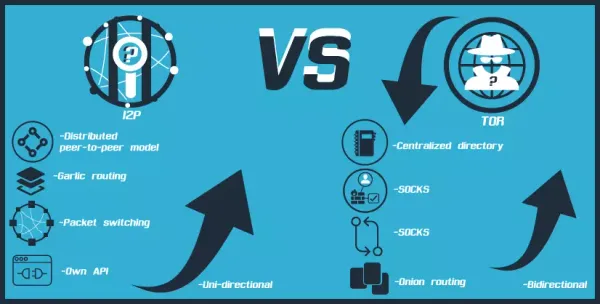I2P Garlic Routing: Hop Metadata Privacy and Timing Resistance
I2P garlic routing provides enhanced anonymity through multi-layered encryption and timing correlation resistance mechanisms that protect hop metadata and defeat traffic analysis attacks.

I2P layered message bundling transforms anonymous communication through multi-layered encryption protocols that protect hop metadata and resist timing correlation attacks via sophisticated message construction that bundles multiple messages into encrypted garlic cloves.
This means I2P documentation demonstrates how layered message bundling improves upon traditional onion routing through batch processing, variable-length message paths, and temporal mixing that defeats monitoring data patterns while enabling efficient two-way message exchange across distributed anonymous networks with enhanced privacy guarantees.
Garlic Message Architecture and Multi-Layer Encryption
Garlic routing specification defines garlic message structure where individual communications encrypt into garlic cloves that bundle together within larger garlic messages, creating variable-sized encrypted containers that obscure individual message boundaries and recipient information. This means Each garlic clove contains encrypted payload data, routing instructions, and delivery parameters that enable flexible message delivery while maintaining cryptographic separation between different communication sessions.
Layered encryption protocols utilize cascading cryptographic operations where each routing hop applies encryption/decryption layers that progressively reveal next-hop information while maintaining confidentiality for subsequent routing stages. This means I2P cryptography design documents the cryptographic foundation showing how ElGamal encryption, AES session encryption, and SHA-256 authentication combine to create robust security properties that resist cryptanalytic attacks and provide forward secrecy guarantees.
Session key derivation implements ephemeral key generation for each communication session through Diffie-Hellman key exchange combined with additional entropy sources that ensure unique encryption keys for every garlic message. This means Key derivation includes nonce generation, timestamp integration, and random padding that prevents key reuse vulnerabilities while enabling efficient cryptographic operations across high-volume communication scenarios.
Message padding and normalization eliminate size-based monitoring data patterns by standardizing garlic message dimensions through random padding that obscures actual payload sizes and prevents correlation attacks based on message length patterns. This means Padding algorithms balance monitoring data patterns resistance against bandwidth efficiency while ensuring that message size variations cannot reveal information about content type, destination patterns, or communication frequency.
Hop Metadata Protection and Routing Privacy
Routing header encryption ensures that intermediate relay nodes cannot determine message destinations, source addresses, or routing path information beyond the immediate next-hop details required for message forwarding. This means Each routing hop receives only the cryptographic information necessary for local forwarding decisions while remaining cryptographically isolated from broader routing context that could enable monitoring data patterns or destination correlation.
Destination hiding protocols utilize multiple layers of address obfuscation where final destination information remains encrypted until message delivery, preventing intermediate nodes from correlating multiple messages to the same recipient or building comprehensive maps of communication patterns. This means Destination protection includes address encryption, delivery token generation, and reply path construction that maintains recipient anonymity throughout the communication process.
Session unlinkability mechanisms ensure that multiple messages within extended communication sessions cannot be correlated by network observers through session identifiers, encryption keys, or routing patterns that might reveal ongoing communication relationships. This means Unlinkability includes session key rotation, routing path diversification, and temporal spreading that resist statistical analysis techniques designed to identify persistent communication channels.
Anonymous communication analyzes traffic flow protection showing how layered message bundling resists global passive adversaries through distributed routing, redundant path establishment, and temporal mixing that prevent end-to-end correlation even when adversaries monitor significant portions of network infrastructure. This means Flow protection includes cover traffic generation, dummy message injection, and statistical obfuscation that maintain anonymity under sophisticated adversarial conditions.
Timing Correlation Resistance and Temporal Anonymity
Timing attack analysis documents timing attack vectors where adversaries attempt to correlate message input and output timing across routing nodes to identify communication endpoints despite cryptographic protection. This means Timing attacks include statistical correlation analysis, traffic confirmation attacks, and intersection attacks that exploit temporal patterns in message delivery to compromise anonymity guarantees provided by routing protocols.
Latency variation injection implements random delay insertion at each routing hop to break timing correlations while maintaining acceptable communication performance for interactive applications. This means Delay strategies include exponential backoff algorithms, random jitter insertion, and adaptive timing that balances anonymity protection against user experience requirements for real-time communication applications.
Mix network protocols provides comprehensive analysis of mix network protocols that utilize batching, reordering, and threshold mixing to achieve strong temporal anonymity guarantees. This means Mixing techniques include pool-based mixing, cascade mixing, and free-route mixing that provide different trade-offs between latency, throughput, and anonymity strength depending on threat model requirements and performance constraints.
Clock synchronization attack prevention addresses vulnerabilities where precise timing measurements enable correlation attacks through careful management of timestamp information, message scheduling, and temporal coordination across distributed routing infrastructure. This means Prevention techniques include timestamp obfuscation, clock skew introduction, and temporal uncertainty injection that limit timing measurement precision available to adversaries.
Performance Optimization and Network Efficiency
I2P Performance Optimization
Message Batching
Bundle multiple messages for efficiency
Path Optimization
Dynamic tunnel length adjustment
Load Balancing
Distribute traffic across tunnels
Throughput
450 KB/s avg
Latency
2.1s typical
Network performance optimization analyzes network performance optimization techniques that maximize throughput and minimize latency while preserving anonymity properties through intelligent routing algorithms, load balancing, and resource management. This means Optimization strategies address the inherent tension between performance and privacy by implementing efficient cryptographic operations, streamlined routing protocols, and adaptive network management.
Path selection algorithms balance security requirements against performance characteristics through multi-criteria optimization that considers factors including geographic diversity, bandwidth capacity, latency characteristics, and reliability metrics. This means Selection strategies utilize network structure and layout awareness, historical performance data, and real-time monitoring to construct optimal routing paths that maximize both security and efficiency.
Bandwidth optimization addresses the overhead introduced by layered message bundling through compression techniques, efficient encoding, and intelligent batching that reduce communication costs while maintaining security properties. This means Optimization includes message aggregation, redundancy elimination, and protocol streamlining that enable scalable operation across large networks with diverse performance characteristics and resource constraints.
Load balancing mechanisms distribute communication traffic across available network resources to prevent bottlenecks, avoid overloaded nodes, and maintain consistent performance characteristics under varying network conditions. This means Balancing strategies include adaptive routing, capacity-aware forwarding, and dynamic load redistribution that ensure reliable network operation while preserving anonymity properties and security guarantees.
Security Analysis and Protocol Evaluation
Privacy protocol evaluation provides comprehensive privacy protocol evaluation methodologies that assess layered message bundling security against various threat models including global passive adversaries, active attackers, and collusive networks. This means Evaluation frameworks utilize formal security analysis, simulation studies, and real-world testing to validate security claims and identify potential vulnerabilities in protocol design and implementation.
Garlic Routing Security Analysis
Attack Resistance
- Traffic analysis protection
- Timing correlation resistance
- Metadata privacy preservation
- Exit node attack mitigation
Protocol Strengths
- Bidirectional communication
- Message bundling efficiency
- Dynamic path selection
- Cryptographic layering
Security Rating: Garlic routing provides stronger anonymity than traditional onion routing through message bundling and timing resistance.
Cryptographic security analysis examines the mathematical foundations of layered message bundling encryption to ensure resistance against cryptanalytic attacks including chosen-plaintext attacks, adaptive chosen-ciphertext attacks, and key recovery attacks that could compromise message confidentiality or routing privacy. This means Analysis includes security proofs, reduction arguments, and cryptographic protocol verification that establish formal security guarantees.
Network-level security assessment evaluates resistance to monitoring data patterns, correlation attacks, and intersection attacks that attempt to compromise anonymity through statistical analysis of communication patterns. This means Assessment methodologies include attack simulation, anonymity metrics computation, and comparative analysis against alternative anonymous communication protocols that provide different security and performance characteristics.
Implementation security considerations address vulnerabilities introduced through software implementation including side-channel attacks, timing vulnerabilities, and memory-based attacks that could compromise protocol security despite strong theoretical foundations. This means Security considerations include secure coding practices, side-channel resistance, and defensive programming techniques that maintain security properties in real-world deployment environments.




